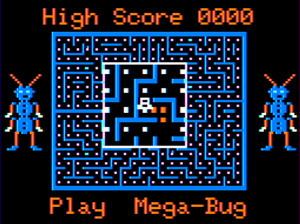Designer(s) Bob Bishop Genre(s) Maze | Release date(s) 1982 Initial release date 1982 | |
 | ||
Similar Tandy Corporation games, Other games | ||
Dung Beetles is an Apple II computer game by Bob Bishop, released in 1982 by Datasoft. The game was ported to Atari 8-bit computers, and also to the TRS-80 Color Computer, where it was distributed by Tandy. On the Color Computer, it was renamed Mega-Bug; however, some copies were sold as Dung Beetles. Later versions for both the Apple II and Atari were named Tumble Bugs; also the Atari version was renamed Magneto Bugs for the 1983 re-release by Gentry Software. In Australia, the game was re-branded Bug Attack.
Contents
Gameplay
The game concept and gameplay are based on Pac-Man, but features a much larger maze and a moving "magnifying rectangle" which makes it easier to see graphic detail of the main character and the opponents, but also obscures a small area of the map near the main character, making short- to medium-range navigation more difficult. In addition, whenever the main character passes through a part of the maze, it leaves a trail of dung. When a dung beetle finds this dung, it eats it and follows the trail; however, if the trail branches, or it encounters a point along the trail, it picks at random which branch to follow, thereby giving the player anywhere from a 50% to 66⅔% chance of losing the pursuer. The player can back-track over his own trail (often necessary as the map can contain dead ends) creating false leads for his pursuers.
Speech
Whenever the player is caught, the game plays a digitized voice saying, "We Gotcha!" This is the only use of voice in the game, and was a novelty, as the Apple II speaker is only able to emit a click. Programmers clicked the speaker rapidly to produce any sound; the typical Apple II game made only monotone beeps and clicks. Programming the game to play back an audio sample, using only a clicking speaker, was a technical accomplishment first seen in 1981's Castle Wolfenstein and present in other games from 1982, including Sea Dragon, Creepy Corridors , and Plasmania.
Reception
Softline called Tumblebugs' magifying glass "an impressive programming feat", and concluded that it was "a solid game ... It could stand some more variety, but it certainly does not lack challenge".
